We may be compensated if you purchase through links on our website. Our team is committed to delivering honest, objective, and independent reviews on home products and services.
Decorative garden elements, from gates to statues to containers and fountains, can create focal points, define spaces, and add character to any space in your yard. By carefully selecting and placing ornaments and considering scale, contrast, and harmony with existing elements, you can transform your garden into a magical retreat. See below for enchanting inspiration from landscape designer Wesley Rouse’s Connecticut gardens.
Find Ornamental Inspiration for Your Garden
Garden ornaments offer endless possibilities for personalizing and enhancing outdoor spaces.
Create Mystery With a Gate
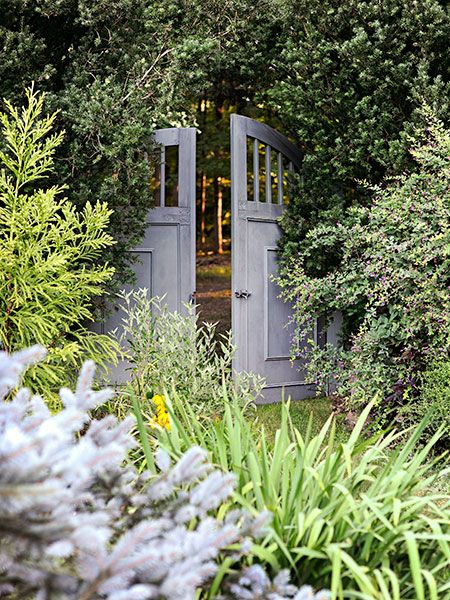
Gates serve as more than just entryways in a garden—they can create intrigue and define separate spaces. One particular gate stands out in Rouse’s garden, serving no practical purpose other than to pause visitors as they transition from a bright, manicured area to a shadowy, moss-covered woodland.
To bring this idea into your garden, consider installing a decorative gate or screen to separate different areas. Even in smaller spaces, you can use lattice walls, curtains hung from trees, or freestanding screens to create a sense of mystery and anticipation as visitors move through your garden.
Ground a White Border With Silver and Gray
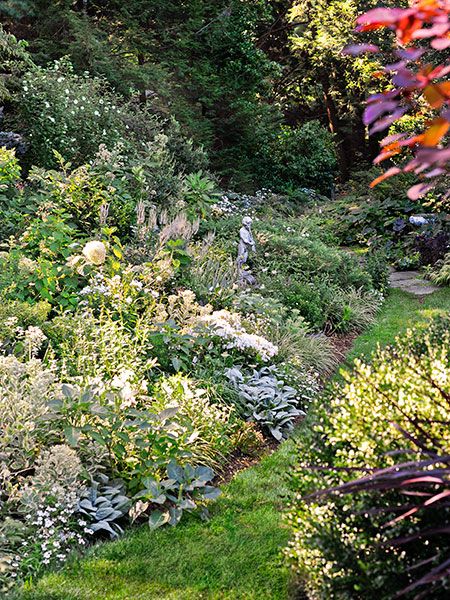
White flowering plants can create a stunning visual impact in a garden, but they often benefit from contrasting elements to truly shine. While many garden designers incorporate silver-leaved plants for this purpose, Rouse takes it a step further by adding metallic ornaments to his white borders.
In this example, a small iron statue in a blue-gray finish perfectly complements the white and silver plantings. The statue grounds the ethereal white flowers of Culver’s root (Veronicastrum virginicum), ‘Snowhill’ hydrangea, and white shrub roses. The silvery foliage of variegated grass (Carex), sedum, and lamb’s ear further enhances these blooms, creating a cohesive and visually striking border.
Consider combining white flowers with silver-leaved plants and metallic ornaments to recreate this effect in your garden. This approach adds depth and interest to monochromatic planting schemes, transforming a simple border into an elegant and sophisticated display.
Frame a View With Fence Panels and Posts
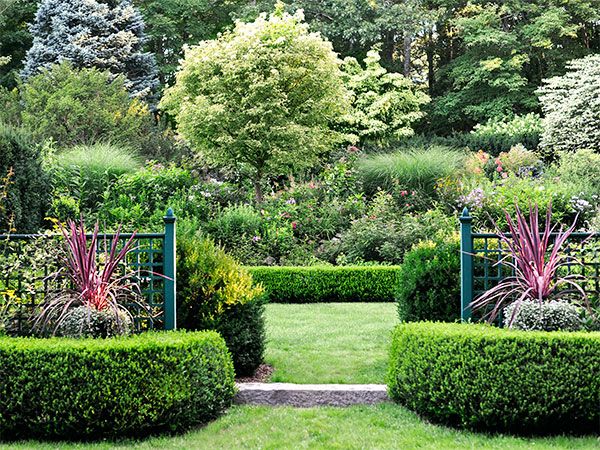
Framing garden views can dramatically enhance the overall landscape design. Rouse demonstrates this technique using open lattice panels to create a defined viewpoint of his formal garden and distant trees. The panels’ airy structure and deep blue color provide a sense of enclosure without obstructing the vista.
Rouse raised this section by about a foot to further emphasize the transition between garden areas. Low boxwood hedges guide visitors toward the entry, their curved shapes softening the geometric lines of the wood panels. This clever use of hardscaping and plants creates a clear delineation between spaces while maintaining a cohesive overall design.
Flanking the lattice panels are large containers planted with a striking combination of ‘Pink Spike’ phormium, ‘Silver Falls’ dichondra, and ‘Morning Light’ maiden grass. These plantings add vertical interest and texture, complementing the structural elements of the design.
Break up a Border With a Shapely Urn
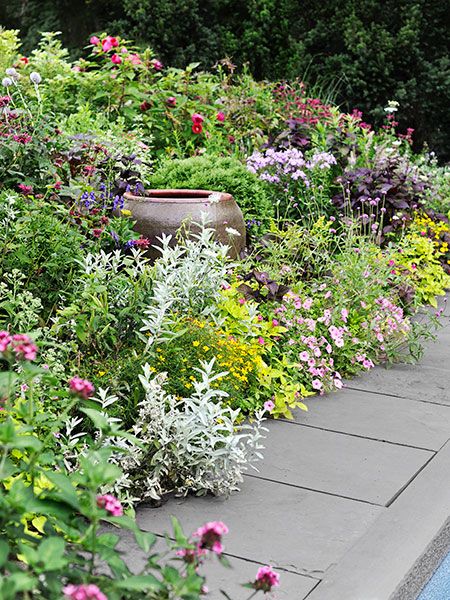
Garden borders can sometimes become visually overwhelming, especially when filled with plants. Conversely, newly planted borders may appear sparse and unfinished. In both cases, strategically placed containers can work wonders to balance the composition.
Rouse demonstrates this technique by nestling a decorative urn into a vibrant border of pink and purple perennials. The urn’s earthy glaze complements the surrounding plants while providing a focal point that breaks up the expanse of flowers. This approach can help guide the eye through a lush planting or distract from areas still filling in.
When adding a container to a border, it’s necessary to create proper drainage and stability. Before setting the container, place a paving stone or a layer of crushed gravel on tamped-down soil. This prevents the pot from sinking and helps excess water drain away from the plant roots.
Offer Respite With a Bench

Benches are versatile garden ornaments that serve both aesthetic and functional purposes. They provide a place to rest and enjoy the garden while acting as sculptural landscape elements. Rouse carefully considers both the placement and material of his benches to enhance the overall garden experience.
In this example, a weathered stone bench is tucked just off the main path in a shaded area. Its placement offers a pleasant surprise to those who venture slightly off the beaten track. The bench’s stone material echoes the color of the brick path, creating a harmonious connection between the hardscaping elements.
Surprise and Delight With Perfectly-Sized Pieces
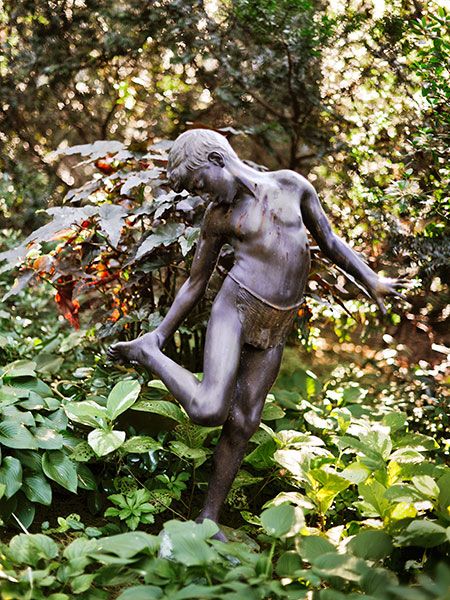
Selecting appropriately sized ornaments is important for creating a balanced garden design. Many gardeners make the mistake of choosing pieces too small for their intended location. Rouse suggests using a simple technique to avoid this common error—cut a piece of cardboard to the dimensions of the ornament you’re considering and place it in various spots around the garden until you find the perfect location.
In this shady garden bed, Rouse chose a foot-tall iron statue with bronze tones that blend seamlessly with the surrounding plants. The statue’s size and color complement the dwarf azalea, hosta, and hepatica without overwhelming the delicate plantings.
Add 3D Focal Points With Fountains
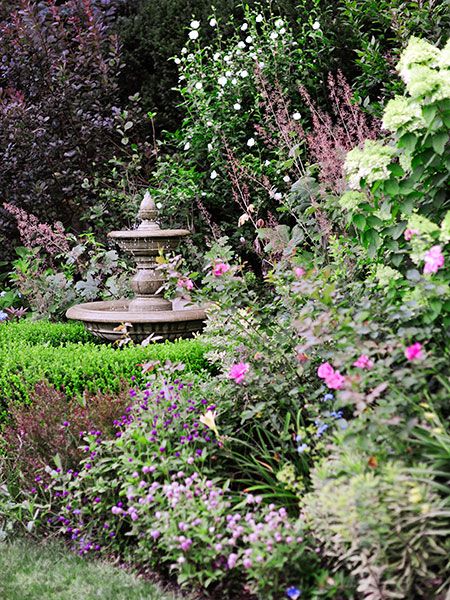
Water features, particularly fountains, can add a dynamic element to any garden. They provide visual interest and soothing sounds and attract wildlife. Rouse often incorporates fountains into his long borders to create three-dimensional focal points and add height and mass to the planting scheme.
When placing a fountain, provide enough negative space around it to showcase its shape and allow for easy viewing. In this example, a tiered cast-stone fountain with a pointed finial echoes the flowering panicles of the ‘Tardiva’ hydrangea behind it. The fountain’s reddish hue also complements the plume poppy in the background, creating a cohesive color palette.
The sound of running water from a fountain can also serve as a natural attractant, drawing visitors through the garden to discover its source. Consider the acoustics of your garden when placing a fountain to maximize its auditory impact. A fountain can turn a static garden into a vibrant and inviting space.
Play It Safe With a Sundial
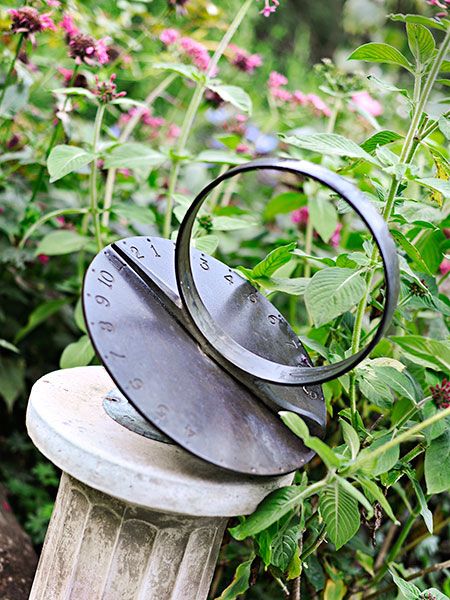
For those who prefer subtler garden art, sundials offer a classic and versatile option. These timeless pieces have a rich history and can complement various garden styles, from traditional to contemporary. Sundials are particularly well-suited for gardeners who want to incorporate art without the bold statement of statues or fountains.
In this garden, Rouse chose a modern metal sundial. By mounting it on a fluted concrete pedestal, he creates a harmonious blend of contemporary and traditional elements that fit seamlessly into the overall garden look. The sundial adds a point of interest without overwhelming the surrounding plantings.
Ideally, position your sundial in a sunny spot where it can accurately mark the passage of time.
Create Contrast With Statues
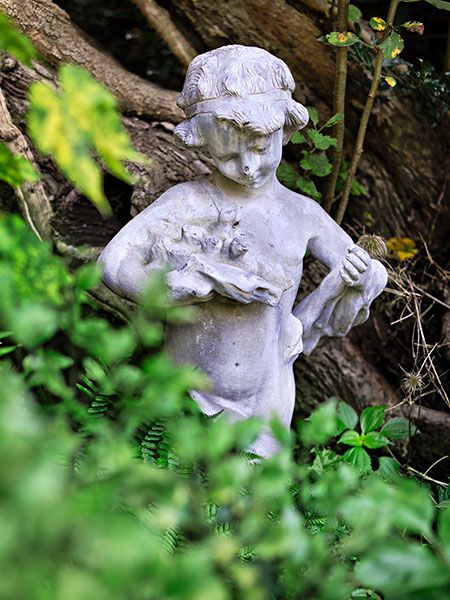
Statues can serve as striking focal points in a garden, especially when they strongly contrast their surroundings. Rouse demonstrates this principle with a concrete maiden statue placed among tree trunks. The statue’s smooth surface and delicate appearance create a captivating juxtaposition against the trees’ rough, woody texture.
When incorporating statues into your garden, consider how their form, material, and color interact with the surrounding plants and hardscaping. A well-placed statue can draw the eye, create a sense of depth, or add a touch of whimsy to your outdoor space.
Make an Entrance With a Container
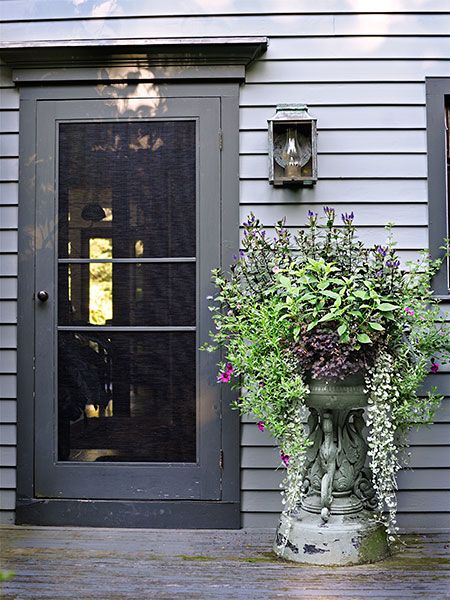
The entrance to your home offers an excellent opportunity to showcase a stunning container garden. Rouse exemplifies this idea with a dramatic planter featuring a swan-figure pedestal near the front door. The height of the container and its plantings help to balance the door’s proportions and fill the space between it and the nearby window.
In this arrangement, cascading ‘Silver Falls’ dichondra and Calitunia (a petunia-calibrachoa hybrid) spill over the edges of the container, softening its lines. These trailing plants are complemented by the upright forms of compact ‘Autumn Glow’ hebe and burgundy oxalis, creating a dynamic and visually exciting composition.
Punctuate a Pathway With a Pot
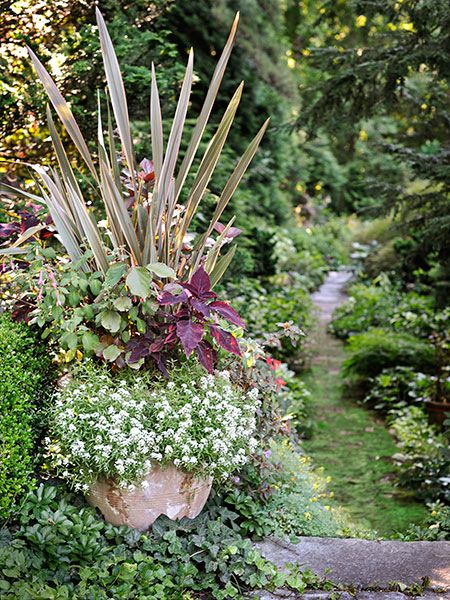
Strategically placed containers can add visual interest and guide movement along garden pathways. Rouse advises choosing larger pots for this purpose to provide ample space for plant roots and for visual reasons. Generally, the container should be about one-third to one-half the height of the mature planting.
In this example, Rouse combines dramatically spiky New Zealand flax with fuchsia, coleus, and sweet alyssum to create a vibrant and textural display. The large pot allows these plants to reach their full potential, creating a lush and eye-catching focal point along the path.
When using containers to punctuate pathways, consider how they will look from different angles and make sure they don’t impede foot traffic. Vary the height, shape, and planting style of containers along a path to maintain visual interest throughout the garden.
Elevate a Container on a Wall
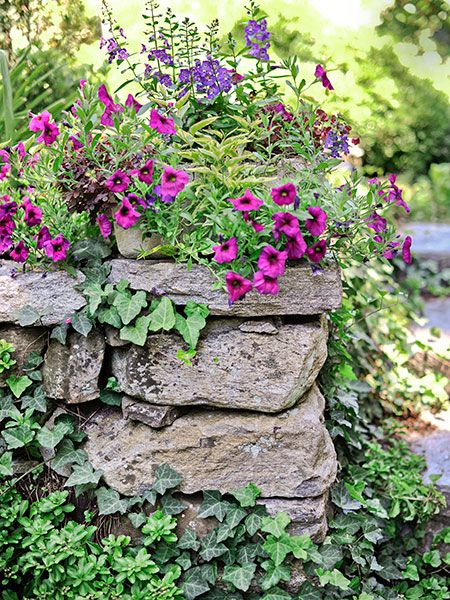
Elevating containers can bring plants closer to eye level and create interesting vertical elements in the garden. Rouse demonstrates this technique by placing a rectangular planter on top of a rustic stacked-stone wall. This positioning allows visitors to appreciate the vibrant mix of colors and textures in the planting up close.
The container overflows with a lively combination of Calitunia, coleus, and angelonia. These plants offer a variety of leaf shapes, flower forms, and colors, creating a dynamic and visually appealing arrangement. The planter’s elevated position also helps soften the wall’s hard lines, integrating it more seamlessly into the garden landscape.
When elevating containers, confirm they are secure and that the supporting structure can bear their weight when fully planted and watered.
Round Out a Corner With a Well-Placed Container
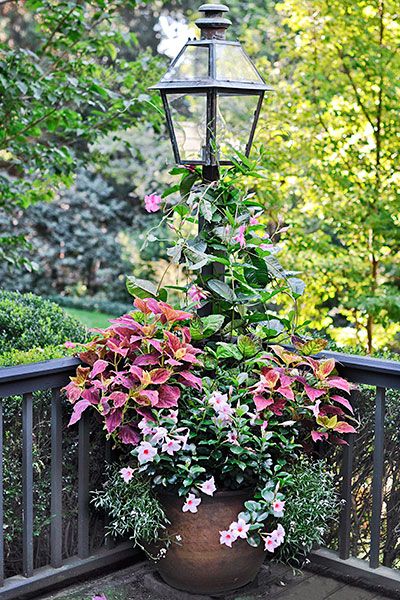
Containers can soften hard lines and fill awkward spaces in the garden. Rouse demonstrates this principle by placing a large pot in front of a deck-mounted lamppost, effectively muting the vertical line and brightening a dark corner.
The planting in this container is carefully composed to complement its surroundings. Annual pink ‘Alice du Pont’ mandevilla climbs the lamppost, adding height and color. ‘Morning Mist’ coleus provides volume and interesting foliage, while pink dipladenia and ‘Snow Princess’ alyssum cascade over the edges of the pot, softening its lines.
